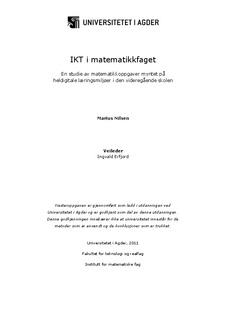| dc.description.abstract | The subject of this master thesis is mathematics in fully digitalised learning environments with a main focus on the tasks that are used in such environments. Traditional text books are not used in fully digitalised learning environments, but tasks are produced and made available through web pages or learning management systems. This arrangement also applies for theory, task solutions etc. In this dissertation, it is the set of tasks provided by National digital learning arena (Nasjonal digital læringsarena, NDLA) that are explored. Through task analysis and interviews with task producers, I have sought answers to the following questions:
Do the tasks, which the pupil activities are based upon, motivate problem solving activity?
- If yes, why and how?
- If no, why not?
Does working with the tasks aimed at digitalised learning environments encourage use of the Internet?
How is the curriculum interpreted when tasks aimed at digitalised learning environments are being produced?
Theoretical overview and tool for analysis
In chapter two a theoretical overview is presented. This is an overview that describes several aspects within the research done on ICT-enriched learning environments. Chapter three includes a tool for task analysis. This tool is constructed from theory, which focuses more directly on the themes of the research questions.
Method
The collection of data was done through qualitative interviews with two task producers at NDLA. One of them, Anders, works as a teacher in an upper secondary school in the Agder region, while the other, Eline, also is a NDLA employee.
Presentation and analysis of the collected data
In chapter five, the data from the interviews is presented before selected tasks are analysed. The tool for analysis presented in chapter three plays the main part in this task analysis.
Findings
The tasks in digitalised learning environments are not very different from the tasks in traditional text books, and this does not seem to be a target either.
The notable differences lie in the manner in which pupils, through dynamic software, can be engaged actively when a new topic is introduced.
The tasks require some use of the Internet. This applies for the tasks that cover goals in the curriculum that mention Internet explicitly and is, in this respect, not a phenomena that is unique in the digitalised learning environments.
The curriculum plays the main part in guiding the production of the sets of tasks at NDLA. However, the production is also based upon the way in which the curriculum is interpreted in the final examination, which pupils undertake | en_US |
